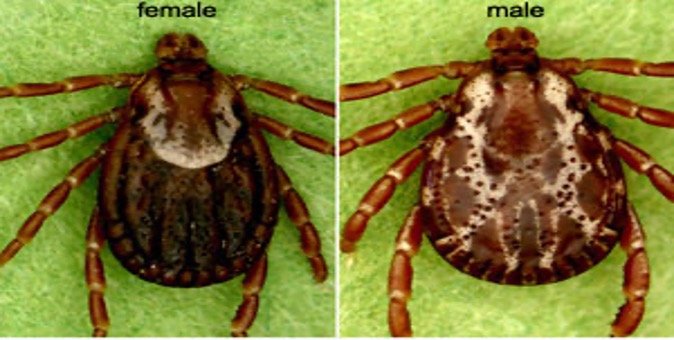Tick Removal – there are multiple tips and tricks to do this, but most sources suggest…
- Using a pair of tweezers (or forceps) and attempting to grasp the tick as close to the skin surface as possible
- Pull upwards with gentle, steady traction. Do not jerk or twist
- Do NOT squeeze, crush, or puncture the body of the tick – this may expel infectious contents
- After removing the tick, wash skin thoroughly with soap and water
What to do if mouth parts remain in the skin?
- UpToDate says to leave it in and they’ll be expelled on their own
- WikEM says to excise under local anesthesia… seems aggressive
Important Ticks for Identification – The CDC has a good guide. If you’re squeamish with bugs, you’ve been warned and please skip this part. There are 3 main types of ticks found in the US.
1) Ixodes Scapularis or “deer ticks” = LYME DISEASE. Other ticks do not transmit Lyme disease
- Brown, about the size of a poppy seed but can be larger when engorged
- Primarily found in the North-East and Midwest, less commonly in the Western US
- Most famously transmits Lyme Disease, also anaplasmosis, babesiosis
2) Dermacentor species or “dog ticks”
- Brown with a white collar, about the size of a pencil eraser
- Primarily found in the Rocky Mountain States (Colorado, Idaho, Montana, Nevada, Utah, Wyoming, etc.)
- Most known for transmitting, you guessed it, Rocky Mountain Spotted Fever
3) Amblyomma Americanum or “Lone Star Tick”
- Brown or black with a white splotch
- Primarily found in the South, but can also be found in the Eastern US
- Most known for Southern Tick-associated rash illness (STARI) and ehrlichiosis
Who needs prophylaxis? IDSA recommends prophylaxis only if ALL OF THESE CRITERIA ARE MET. It should be specified that this is for prophylaxis against Lyme Disease only.
- The tick is identified as a deer tick
- Tick is estimated to have been attached >36 hours or engorged (it takes time for the bacteria to exit the gut of the tick and enter the bloodstream). Ticks found crawling on skin automatically do not count.
- The antibiotic can be given within 72 hours of tick removal
- The bite occurs in a geographic location that Lyme Disease is highly endemic (can be found on CDC website)
- There is no contraindication to take doxycycline (primarily appears to be hypersensitive or children < 8). If there is a contraindication, no second-line antibiotic exists
The prophylaxis is a single dose of 200mg doxycycline, or 4mg/kg up to a max of 200mg for children.
Antibiotic treatment following a tick bite is not recommended as a means to prevent anaplasmosis, babesiosis, ehrlichiosis, Rocky Mountain spotted fever, or other rickettsial diseases. Rather, patients should be warned and be vigilant against symptoms such as fever, rash, or other symptoms concerning for these diseases.
https://www.cdc.gov/ticks/tickbornediseases/tickID.html
https://wikem.org/wiki/Tick_borne_illnesses
https://wikem.org/wiki/Tick_removal







